Highlights
- Republicans have delivered on a key election promise – lower taxes. Congress is on the verge of passing the Tax Cuts and Jobs Act (TCJA), at a cost of $1.5 trillion over the next ten years.
- The biggest permanent change that will reinforce U.S. international competitiveness is the drop in the corporate income tax rate to 21% from 35%.
- In order to pass the bill with a very narrow majority in the Senate, cuts to personal taxes will expire in 2025. This sets up a fiscal cliff battleground for a future administration.
- The tax cuts will provide a modest economic boost over the near term. In the forecast we published on December 14th, prior to the final conference agreement for the TCJA, we had incorporated a 0.1 and 0.3 percentage point lift to GDP growth in 2018-19, respectively.
- Subsequently, the agreed-plan has front-loaded more of the tax cut into 2018. This suggests the 2018 fiscal boost could be nudged up to 0.2 percentage points.
- With an economy very close to full employment, a fiscal boost is likely to lead to higher inflation, and a slightly faster pace of rate hikes.
- It will also add to a national debt level already set to rise. Over the medium term, this poses several risks to government finances and the economy. The TCJA ultimately reflects an inter-generational shift of the tax burden to future taxpayers.
Republicans in the Senate and the House have passed a compromise tax reform bill that will soon be passed into law. At a total cost of $1.5 trillion over ten years, it will provide a modest short-term boost to the U.S. economy, but not enough to offset the full cost of the plan. As many provisions of the tax cuts expire and higher interest rates weigh on growth, the plan will switch from stimulus to economic drag over the medium term. Barring severe spending cuts to pay for the tax cuts, the U.S. debt-to-GDP ratio is expected to rise above its already worsening outlook.
Our recent Quarterly Economic Forecast incorporated a boost from tax cuts for the first time. We estimated that real GDP growth would be lifted of 0.1 percentage points in 2018 and 0.3 percentage points in 2019 on a Q4/Q4 basis as a result of the tax cuts. Now that the final details of the plan are known, the size of the tax cut is somewhat larger in 2018 than we had assumed, putting some upside risk to our December forecast. However, tax cuts remain skewed to higher income taxpayers, who have a much lower propensity to consumer out of savings. In addition, it takes time for firms to adjust their business and investment objectives to a new corporate tax regime. Therefore we continue to expect the immediate economic lift from tax cuts to be modest. Moreover, the U.S. is essentially operating at full employment and the Federal Reserve is well underway in removing monetary stimulus. We expect that faster growth could result in higher inflation and be met with at least one additional rate hike by the Federal Reserve over the next two years relative to our prior baseline forecast in September.
Nuts & Bolts of the package
The price tags of key elements of the plan are shown in Table 1 and a summary of key changes relative to the current system are shown in Table 2 (for more details please see the Appendix). The biggest change is arguably the permanent drop in the corporate tax rate from 35% to 21%. That puts America’s CIT rate below the OECD average and enhances its competitiveness versus its trading partners (see Chart 1).
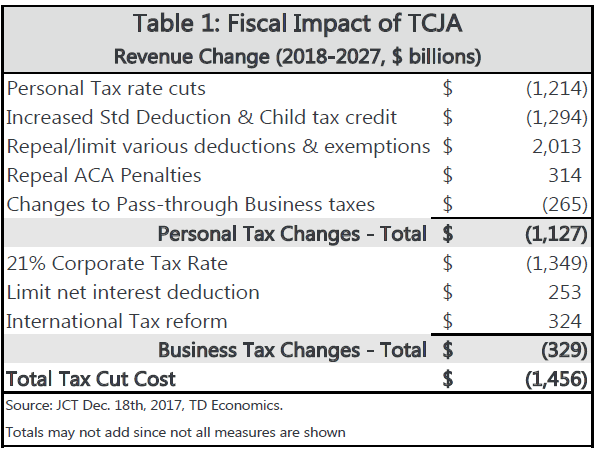
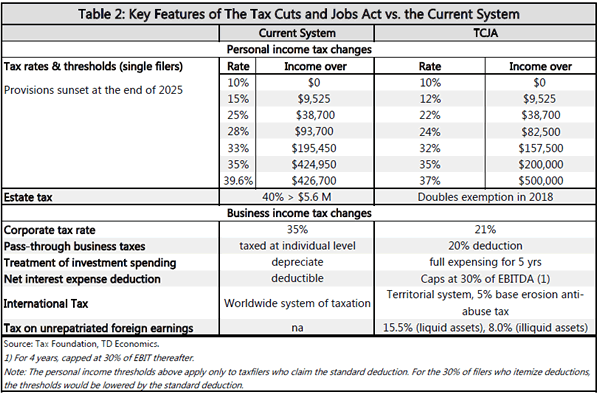
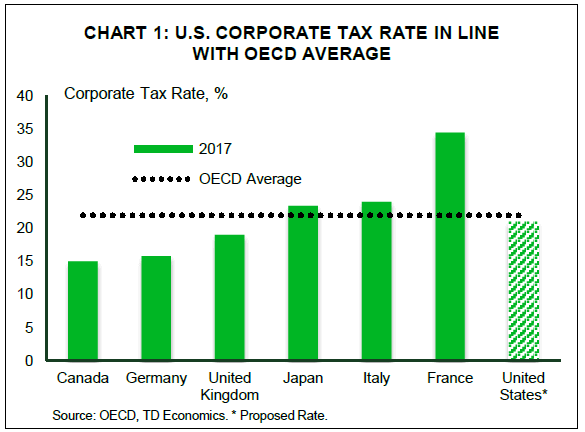
There are tax cuts on the personal side too. However, to make the package fit in Senate budget rules, most elements on this front are set to expire in 2025. This includes the tax cuts for pass-through businesses, which are on the personal side of the income tax system. The sunset clause sets up a future administration for another fiscal cliff, faced with the tough decision to either let taxes reset back to higher ranges, or extend the cuts. The latter would further worsen an already bleak U.S. budget situation.
Another change that hasn’t received a lot of attention is a move to change the inflation measure for items of the tax cut that are indexed to inflation. The system will move to the Chained CPI measure, from a traditional CPI measure. On average, the chained measure is lower than the traditional one, meaning the benefits of various deductions and credits that are indexed to inflation will grow more slowly, as will the level of tax brackets. This saves the government money versus the previous system.
Modest fiscal bump….
While the TCJA makes major changes to the tax system, we do not expect it to be a game changer for the U.S. economy. The tax cuts are expected to provide a modest lift to consumer spending and business investment over the first few years of the plan. On the personal side, estimates from the Tax Policy Center of the conference plan as of December 15th note that overall average after-tax income would rise 2.2% or about $1,600 in 2018. However, those benefits are greatly skewed to higher-income individuals. Taxpayers in the middle-income quintile (those with income between $49,000 and $86,000) would receive an average tax cut of about 1.6% or $900. In contrast, taxpayers in the 95th-99th percentile of the income distribution will see the largest boost to income in percentage terms, 4.1% or $13,000.
The scale of fiscal stimulus is larger this time around than that of mid-2008, which was about $500 per household and during a deep economic recession. The TCJA is occurring at a time when consumer spending was already on track to grow by 2.7% in real terms in 2017. We incorporated a boost to consumer spending in our recent forecast of approximately 0.2 percentage points in 2018 and 0.4 percentage points in 2019 (on a Q4/Q4 basis). With the final details of the tax plan in hand, there is a slight upside risk to this view. However, given the distribution of the tax cuts to upper incomes, and the likely lift to inflation, we continue to expect the lift to spending in real terms to be modest. In a previous report, we outlined a table that demonstrated that multiplier estimates are lower for tax cuts to upper income households, due to a lower marginal propensity to consume out of an additional dollar of income.
A permanently lower corporate tax rate and the ability to fully expense spending on equipment are forecast to boost business investment over the next few years. That boost is mitigated somewhat by the cap on the interest deduction, which raises the cost of debt-financed investments. Growth in business investment already had considerable momentum at the end of 2017 and was set to be upgraded for 2018 even before the tax cut. Our outlook has been lifted slightly, and to a greater extent in 2019-20 as companies adjust capital spending budgets.
As part of the transition from a worldwide to a territorial tax system, businesses will be required to repatriate profits from overseas operations at a reduced tax rate (15.5% on liquid and 8% on illiquid assets). Right now, many corporations have deferred profits held overseas as they only pay taxes once the profits are repatriated. Republicans hope this will cause U.S. businesses to invest domestically and/or raise wages. The move is estimated to raise roughly $340 billion in revenues for the Federal government over the next ten years.
However, the U.S. did a similar tax holiday in 2004, and subsequent analysis showed that companies spent 79 cents of every dollar on share repurchases and 15 cents on dividends. There was no evidence of an increase in domestic investment. This is good news for equity markets and shareholders, but may not lead to as much capital spending as hoped. The administration believes that a more competitive international tax rate should result in more investment domestically relative to other jurisdictions. This is difficult to model, and if it is indeed the case, there is upside risk to our business investment outlook over the medium term.
The lower tax rate does reduce the user cost of capital, and will likely lead to higher levels of investment relative to our previous base case view. Over the medium term, capital deepening would lead to a slightly faster pace of potential growth through a better productivity performance. But, it takes time to shift the supply side of the economy, and we expect the effect will be modest, on the order of a tenth of a percentage point on potential growth.
… But could make the porridge too hot
The biggest uncertainty in the outlook is how the Federal Reserve will respond to a fiscal boost at a time when the economy doesn’t need one. Stronger economic growth is expected to drive a low unemployment rate even lower (Table 3). Given the further drop in the unemployment rate assumed in our December forecast, we now expect the Fed to raise rates one more time by the end of 2019. However, there is greater than usual uncertainty about how the Fed will respond. There will be a higher level of turnover on the Federal Reserve Board’s Open Market Committee over the next year. If new board members are more hawkish, you could see a quicker trigger on future rate hikes. At the same time, new members could also be more cautious about leaning against Washington’s tax cuts.
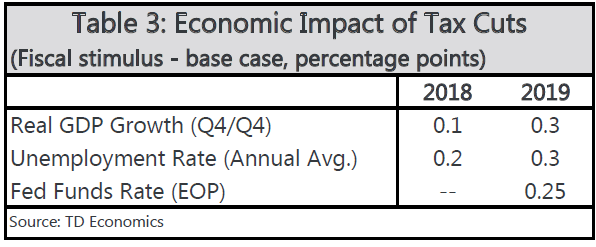
The unemployment rate is already below the Federal Reserve’s estimation of the natural rate, and most measures of labor underutilization are back to their pre-recession lows. Our forecast for a slightly lower unemployment rate requires continued improvement in the labor force participation rate, as strength in job demand and wages draws more people into the labor market. However, we could be wrong on this assumption and it may prove difficult to raise participation rates higher. If so, the unemployment rate would drop even faster than anticipated, intensify wage pressures and paint the Federal Reserve into a corner to respond with more offsetting rate hikes.
Beyond the first four years of the plan, the fiscal stimulus shifts to fiscal drag, making growth slightly lower than it otherwise would have been. This is due to several factors, including the expiration of some provisions, while other measures become less generous, including the lower inflation measure. According to the non-partisan Joint Committee on Taxation’s analysis, average tax rates fall initially but then start to rise, shifting the plan from a fiscal stimulus to a fiscal drag. Moreover, since the Fed would lean against faster inflation, the economy would be expected to grow more slowly in the out years than previously expected. That is one of the ways in which the tax cut is really short-term gain for longer-term pain.
Tax cuts make a bad fiscal situation worse
Third party estimates suggest that even after accounting for additional economic growth, the tax plan could add over $1 trillion to the debt level by 2027. This is concerning given the federal government was already facing a deteriorating fiscal situation. Expenditures related to an aging population (Social Security and Medicare) and a rising share of interest payments were already conspiring to expand the deficit after 2019 (Chart 2).
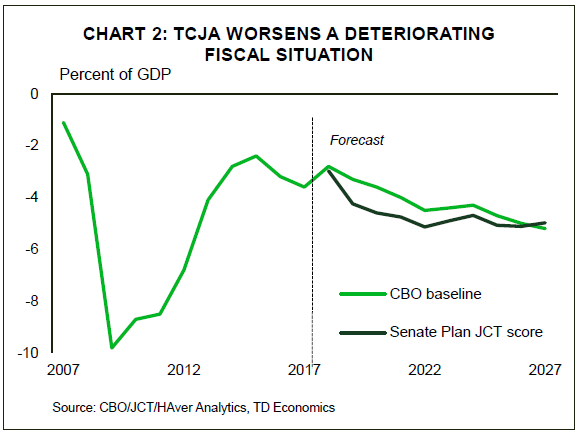
Even though much of the tax cuts must sunset in 2025, deficits are still larger in the intervening years. That adds to the debt burden and arguably gives the government less flexibility to respond to an economic downturn. Republicans also speculate that the tax cuts would eventually be made permanent by a future government. But, the Committee for a Responsible Federal Budget estimates that the cost of extending various aspects of the plan could be between $500 and $750 billion. This would need to be paid for with reduced spending elsewhere or risk even larger deficits and related debt-service costs. This represents an inter-generational shift of risks to the younger generation of taxpayers. The required policy response could boomerang back in creating a less competitive economic climate for Americans.
Although the budget resolution passed by Congress earlier this fall contained massive spending cuts to get the budget back to balance on paper, it remains to be seen whether this will actually occur. The present magnitude of cuts suggests it’s unlikely. The U.S.’s debt to GDP is already projected to rise from 106% to 110% by 2027. Without significantly offsetting spending cuts, the ratio would rise to 114% under the Senate’s earlier version of the tax cut plan.
A higher debt burden will cause interest costs to eat up more taxpayer dollars, leaving less room for other priorities. A higher government debt burden crowds out investment in the private sector, dampening productivity growth over the longer term. The likelihood of a fiscal crisis also increases, should investors become unwilling to finance the government’s borrowing without greater compensation via higher interest rates.
Great haste makes great waste
Facing mid-term elections in 2018, Republicans were under a great deal of pressure to get some part of their agenda passed. Adding to the pressure, the narrow GOP majority in the Senate is set to get narrower with the newly elected Democratic Senator from Alabama to take office in January. The final conference tax plan was assembled quickly, and key Republicans are already admitting that Congress would need to draft another bill to make "technical corrections" as problems arise. This could prove troublesome in a divided Senate.
Moreover, despite a stated desire for simplicity in the tax system, the tax changes for pass-through businesses arguably make the tax system more complicated. It also provides an incentive for high earners to find ways to reclassify their personal income as business profit. There are limits to the type of business that can claim the deduction, but sorting out who qualifies will take time and will prove a challenge for the IRS.
The Bottom Line
Republicans have delivered one of their key election promises, lower taxes. But, with the U.S. economy in the mature stages of an economic expansion, there is little economic rationale for trading off more economic stimulus for more government debt. The exception is the situation of boosting productivity via capital deepening within corporations or within America’s infrastructure. The latter is nowhere to be seen in this bill. In the past, both parties have agreed that the corporate tax rate should be lowered, and this plan successfully brings it down to a competitive level. It levels the playing field for the U.S. to attract more investment, which could provide a much-needed productivity boost.
In the meantime, the economy is operating at essentially full capacity, fiscal stimulus is likely to boost wages and inflation and lead to a faster pace of tightening by the Federal Reserve, which dampens the boost from the tax cut. It also raises the risk of a policy error, where the Fed might overreact to the amount of stimulus in the economy and tighten rates too much. Moreover, the U.S. already faces a worsening fiscal situation and a tax cut digs the government deeper into a hole. Larger deficits at a time when borrowing costs are rising presents a key downside risk for the U.S. economy over the medium term.
Appendix
Personal Income tax
- Lowers tax rates, but retains seven brackets in contrast to earlier versions of the plan which had a flatter structure.
- The standard deduction was roughly doubled to $12,000 for single filers, while the personal exemption was eliminated and the Child tax Credit was increased to $2000.
- The State and Local tax (SALT) deduction is capped at $10,000.
- The mortgage interest deduction (MID) is capped at $750,000 for new loans, while eliminating the deduction for equity debt.
- Repeals penalty payments for not having insurance as was the case under the Affordable Care Act. This saves the government money by not having to pay insurance premium subsidies.
- Businesses gain a 20% deduction for pass-through income, which sunsets after 2025. This is limited to the greater of 50% of wage income or 25% of wage income plus 2.5% of the cost of tangible depreciable property for qualifying businesses. This benefit will not be available to many businesses in the services sector. Limitations do not apply for those with incomes below
- $315,000 (joint filers) and phase out over a $100,000 range.
- The estate tax is retained, but the exemption level is doubled, and will rise with inflation going forward.
Corporate income tax
- Corporate tax rate falls to 21%, effective January 1st, 2018, and the Corporate Alternative Minimum Tax is repealed.
- Businesses will be able to fully expense short-loved capital investment, such as machinery and equipment for five years. And raises the small business expensing cap to $1 million.
- The interest deduction is capped at 30% of EBITDA for four years, and 30% of EBIT thereafter (making it less generous). This will raise the cost of debt-financed investment, and therefore offsets somewhat, the boost from full expensing and a lower CIT rate.
- Eliminates net operating loss carrybacks while providing indefinite net operating loss carryforwards, limited to 80% of taxable income.
- Increases small business eligibility for cash accounting from $5 million to $25 million in income.
- Moves to a territorial system with anti-abuse rules and a base erosion anti-abuse tax (BEAT) at a standard rate of 5% of modified taxable income over an amount equal to regular tax liability for
- the first year, then 10% through 2025 and 12.5 percent thereafter, with higher rates for banks.
- Enacts a deemed repatriation of currently deferred corporate profits at a rate of 15.5% for liquid assets and 8.0% of illiquid assets.













